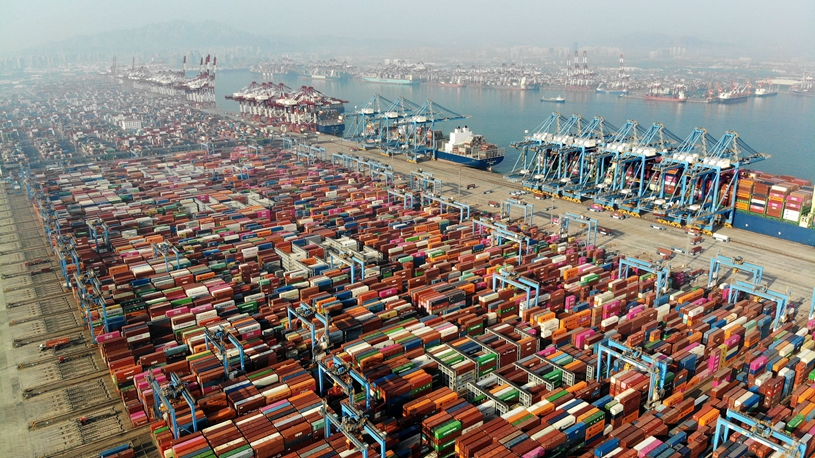* China has the largest NEV market in the world, and its number of NEVs in use had risen to 20.41 million by the end of 2023.
* In recent years, China has made great strides in unlocking the potential of its new energy industry, not only as a way to achieve its dual carbon goals of peaking carbon emissions before 2030 and reaching carbon neutrality before 2060, but also as a means to improve the quality of people's lives through low-carbon pathways.
* Known as a new energy capital, Changzhou in east China's Jiangsu Province reported a regional gross domestic product (GDP) of 1.01 trillion yuan (about 140.8 billion U.S. dollars) in 2023, up 6.8 percent year on year, according to the local statistics department.
by Xinhua writers Liu Kang, Zhang Zhanpeng, He Leijing and Ye Ting
NANJING, Feb. 15 (Xinhua) -- Amid the surge in the number of electric vehicles cruising roads worldwide, it remains a lesser-known fact that the battery propelling a tenth of such vehicles originates from the unassuming Chinese city of Changzhou.
Known as a new energy capital, Changzhou in east China's Jiangsu Province reported a regional gross domestic product (GDP) of 1.01 trillion yuan (about 140.8 billion U.S. dollars) in 2023, up 6.8 percent year on year, according to the local statistics department.
With a population of over 5 million, Changzhou has become the least populated Chinese city to have a regional GDP of over 1 trillion yuan, and has joined Suzhou, Nanjing, Wuxi, and Nantong as the fifth city in Jiangsu Province to achieve this milestone.
In recent years, China has made great strides in unlocking the potential of its new energy industry, not only as a way to achieve its dual carbon goals of peaking carbon emissions before 2030 and reaching carbon neutrality before 2060, but also as a means to improve the quality of people's lives through low-carbon pathways.
"The new energy industry is a winning formula for Changzhou's development," said Chen Jinhu, Party chief of Changzhou.
"For Changzhou, new energy is not just an industry, as the ultimate participants and beneficiaries of promoting green and low-carbon development are the people," said Wang Xiaodong, a Changzhou official.
The only solution to the problem of carbon emissions for developing countries is to develop a more resilient green economy, said Richard Kozul-Wright, director of the globalization and development strategies division under the United Nations Conference on Trade and Development.
The progress of Changzhou is the epitome of how China is continuously moving toward a green transition.
NEW ENERGY HIGHLAND
The output value of the new energy industry in Changzhou reached about 768 billion yuan last year, and the city aims to expand the output value to over 1 trillion yuan by 2025, according to Chen.
This ambitious goal amounts to more than mere rhetoric, as numerous workshops that have gathered more than 3,000 new energy-related enterprises are in full swing in the city.
Recent data showed that the industrial chain integrity of power batteries in Changzhou has reached 97 percent, ranking first in China, while the output accounts for 20 percent of the country's total.
The city also manufactures 10 percent of the total number of photovoltaic cells and modules made in China, while Changzhou produced some 700,000 NEVs in 2023, accounting for 70 percent of the total number manufactured in Jiangsu.
Power battery giant Contemporary Amperex Technology Co., Ltd. (CATL) has since 2016 invested more than 40 billion yuan in Changzhou to build a super-large production base there. In addition, NEV makers like BYD and Li Auto have also established manufacturing footprints in this city.
At the plant of automotive supplier Faurecia, large numbers of car seats are efficiently manufactured and seamlessly delivered to BYD's smart factory only a few kilometers away. In January 2022, BYD began to roll out NEVs in Changzhou, leading to the formation of a complete local NEV industrial chain.
"Changzhou's new energy industry cluster is highly developed and concentrated, so it fosters strong innovation capacity and great efficiency in production," said Zhang Yaojun, a professor from Renmin University of China.
At the 59,000-square-meter assembly workshop of Li Auto in Changzhou, different kinds of auto parts are collected and carried in an orderly fashion by automatic guided vehicles and then converted into diverse luxury NEVs.
The Changzhou-based NEV company delivered 376,000 cars in 2023, up 182.2 percent year on year, while the average price of its cars exceeded 300,000 yuan. "We plan to deliver 800,000 vehicles and build 2,000 supercharging stations in 2024," said Li Xiang, CEO of the company.
The robust growth of Li Auto is inseparable from the new energy innovation strength found in Changzhou. Data showed that as of October 2023, the city had boasted 5,315 new energy industry invention patents, accounting for 21.9 percent of the city's total.
China has the largest NEV market in the world, and its number of NEVs in use had risen to 20.41 million by the end of 2023. China also exported 1.2 million NEVs last year, a 77.6 percent increase from 2022, with BYD becoming the world's leading seller of pure electric vehicles in the fourth quarter of 2023.
The exports of the three major tech-intensive green products -- new energy vehicles (NEVs), lithium-ion batteries, and photovoltaic products -- in the city amounted to 29.97 billion yuan last year, marking a year-on-year increase of 12.3 percent and claiming a 15.4 percent share of the total such exports in the entire province.
Notably, lithium-ion batteries witnessed remarkable growth of 36.5 percent, while exports of electric passenger vehicles soared by over 165 times.
The city is sharing development opportunities with the world, as plenty of foreign-funded companies in the new energy sector have chosen to settle in Changzhou and benefit from the local industrial chain.
"We choose Changzhou because we need a place where we can get to scale very quickly and Changzhou offers a unique combination of supply chain infrastructure," said Jorg Heinemann, CEO of American firm EnerVenue, a storage battery supplier.
"We want to be a very large part of Changzhou's new energy vision, and we want to get to scale here and grow very big in this location," Heinemann added.
LOW-CARBON CITY LIFE
The concept of green development has enabled Changzhou not just to prosper economically and reduce carbon emissions, but also to create a low-carbon lifestyle for its residents.
The city recently built an advanced heat-storage station, which can extract leftover heat from industrial waste to produce and store steam at about 160 degrees Celsius. The steam can be used by textile and apparel enterprises, thus greatly promoting the sustainable utilization of energy.
Such energy-saving technologies are widely used in Changzhou, as the industrial hub has been actively promoting the application of energy-efficient methods to cut energy consumption intensity. It achieved an 11.1 percent reduction in its energy consumption per unit of GDP in 2022.
The decarbonization process in Changzhou has progressed steadily. The city adopted an iron-fist approach to managing the discharge of industrial waste and also increased technological support for traditional manufacturing enterprises to help them go green.
The construction industry is one of the main contributors to carbon emissions in China. In this regard, Changzhou has built the country's only demonstration zone for the green building industry cluster. It added 13.5 million square meters of green building area last year.
The number of electric vehicles on the streets of Changzhou has increased. "It's cleaner and greener, and the passengers are more satisfied," said Wang Cheng, a bus driver, noting that all the gasoline buses in the city were replaced with electric ones in 2023.
The construction of charging stations for NEVs has also accelerated. NEV owners can now find a public charger within a five-minute drive anywhere in the downtown area of Changzhou.
Chen Xiaolong, a Changzhou resident, chooses a more futuristic way of getting around the city -- a hydrogen bicycle. This environmentally friendly bicycle was developed by Changzhou-based Youon Technology Co., Ltd.
"It is easier to ride, only costs 0.5 yuan for half an hour, and has a cruising range of up to 70 kilometers," Chen said.
A low-carbon philosophy can also be reflected via urban greening, and Changzhou has been integrating its park landscapes with the urban space to transform itself into a tree-lined city.
"Ecology is the most competitive environment for development," said Wang Xiaodong, while also noting that the per capita green area in Changzhou has reached nearly 15 square meters.
"Green development can be clearly seen, as the city now has more trees and less pollution, and there are more energy-saving and carbon-reduction initiatives happening. The air is cleaner and fresher now," said Zhou Xiafeng, who has lived in Changzhou for over 50 years.
(Video reporters: He Leijing, Xia Peng; Video editors: Zhang Chengyu, Zhao Xiaoqing, Wu Yao, Ma Ruxuan) ■












